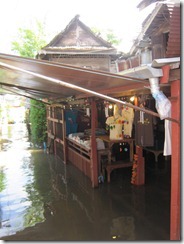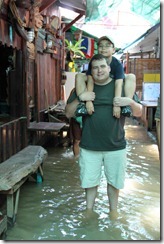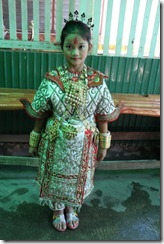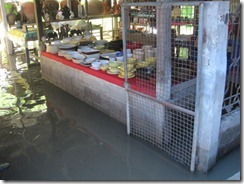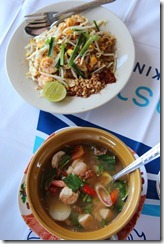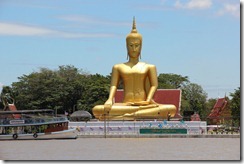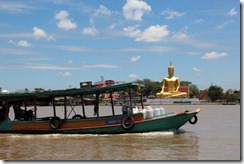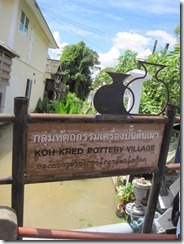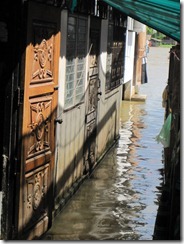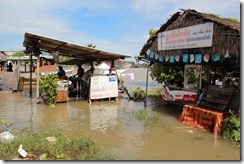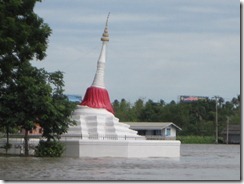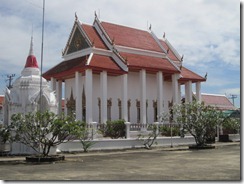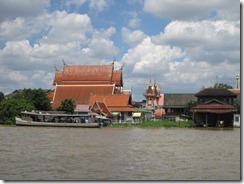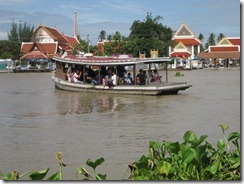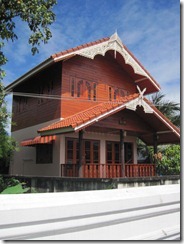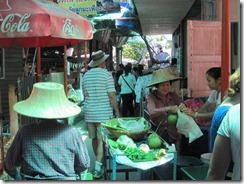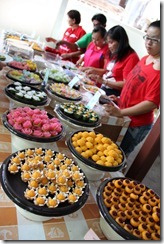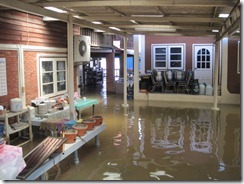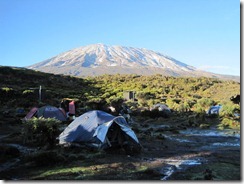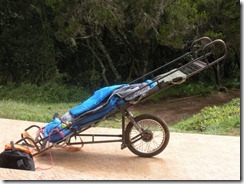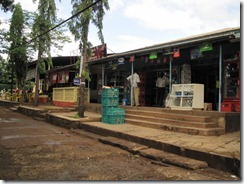Koh Kred, Thailand (part two)
The water level rose higher the farther we walked and flooded the market on Koh Kred. We assumed the corridor where we were walking would reclaim the high ground and pressed on with bare feet, wading through the water until we reached dry ground again. I enjoyed the exotic feel of wading through floodwater; my son and wife did not share my enthusiasm and fretted over whether critters lurked in the water waiting to nip their toes or infiltrate their bodies. I was reassured by the flowing water that it did not carry waterborne diseases common in stagnant cesspools. Just to be safe, I gave my son a piggy back ride through the water, much to his relief.
We crossed two more flooded areas. Again on dry land, we dried our feet and put on our shoes. The floodwater was a novelty but distracted us from shopping in the market, a sentiment likely shared by other visitors around us judging by the empty shops with nary a shopper. Performers dressed in ethnic Thai garb entertained a nonexistent crowd at a small outdoor theater. The water held their potential audience at bay.
Water overtook the corridor again, and we waded into it one more time. The flooding was more extensive here. We wandered through the flooded corridor for a few minutes vainly searching for dry land, but none was in sight. My wife and I decided to turn around and head for lunch instead. We had had enough of the submerged market!
We stopped at a riverside restaurant on stilts jutting into the Chao Phraya River. Delicious Thai food simmering in trays wafted from a small counter in the middle of the restaurant. I played it safe and ordered pad Thai, the quintessential Thai dish; my son ate his usual fried rice with shrimp; and my wife chose pad see ew, a noodle dish she’s taken a liking too since she arrived in Thailand. The restaurant staff cooked our meal in the dining area not far from our table. About fifteen minutes later, we were feasting on a cheap, delicious Thai meal overlooking the mighty Chao Phraya.
A giant gold Buddha more than 25 meters tall sat cross-legged across the river from us in of Koh Kred Island. The Buddha is a most prominent feature of Wat Bangchak temple on the northern bank of the river. The beautiful Buddha meditated serenely with his hands pressed together in prayer at the edge of the flowing river, shining ever brighter amid the deep greenery.
Ferries from felucca-style boats to something out of the African Queen traversed up and downriver to drop off or pick up passengers. A few fishing boats skimmed the water with underpowered motors in search of abundant fish churning the water as they jumped to catch insects on the surface. We sat next to the water and looked down at the cauldron of fish below us.
After lunch we waded back through the water to higher ground protecting the island’s largest temple, Wat Paramaiyikawatworawihan, from flooding. The sun fried us from all sides, from the heavens and to its reflection on standing pools of water. We tried to enter another market known selling for Monam Lai Wichit terracotta pottery, but the floodwaters barred our way. We aborted our shopping trip and vowed to return after the rainy season ended.
As we waited to take the ferry back to the urban sprawl of Bangkok, we indulged in one more helping of coconut ice cream, and I filled out a survey for a group of Thai students who wanted to improve their English. The day ended with an unfulfilled shopping trip and more than our fill of aquatic adventure.

